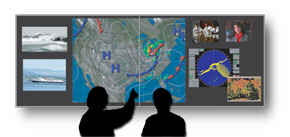|
|

|
|
Photo by RGB Spectrum |
Like the model 2000 and 2500, the new MediaWall is unique among display wall processors, based upon a custom, high performance architecture rather than a PC, with faster updates, true real-time performance, more display flexibility, robustness, and security. Real time display of all inputs is guaranteed under all conditions, at up to 80 frames per second without any dropped frames.
The new MediaWall 1500 displays up to six video and computer signals simultaneously on two screens. Images can be displayed any size, anywhere, within or across screens, in correct aspect ratio or stretched to fit, in whole or zoomed to emphasize details. The system offers plug-and-play compatibility with the widest range of inputs at up to 1920 x 1200 pixel resolution, including non-interlaced and interlaced, RGB/DVI, HD 720p/1080i/1080p, radar, sonar, X-Ray, YUV component, S-Video, and composite NTSC/PAL. Background images, up to the aggregate resolution of the display wall, can be loaded from compact flash cards or via network connection.
Unlike other video walls, the MediaWall has no limits on display alternatives; the two-screen array forms a truly virtual screen in which any display of windows is possible. MediaWall 1500 offers many innovative display features, including dynamic window sizing and positioning, enhanced image zoom capability, custom borders, window titling, 24 user programmable display arrangement presets and colored and shaded backgrounds. No competitive video/data wall even comes close. Available options include Advanced WCP (on-screen clock, cursor control and multi-level user security) and the Integrated Control System with KvM.
The MediaWall 1500 is a robust system designed for 24/7 mission critical operation. It comes packaged in a rack mountable enclosure with replaceable air filter, redundant power supplies, and thermostatically controlled fans, providing a, excellent solution for challenging environments. Most importantly, in contrast to PC-based walls, MediaWall provides the security and reliability of an embedded operating system. It is not vulnerable to security breaches or downtime due to network glitches or PC operating system failures.
Leading edge features include both mullion compensation and image overlap to support a full range of display alternatives. The mullion adjustment capability allows shifting and expanding images across screens to compensate for the dead spaces of flat panel displays. The result is proper, optimized alignment from screen-to-screen to provide a contiguous image. Image overlap is used in conjunction with projectors edge-blending capability for a seamless image across a large screen.
Control is offered via Ethernet or RS-232 serial port. A web browser based control system provides both local and remote control. An embedded GUI interface provides a graphical representation of the multi-image screen with "drag and drop" window positioning and sizing.
For more information, please send your e-mails to swm@infothe.com.
ⓒ2007 www.SecurityWorldMag.com. All rights reserved.
|



